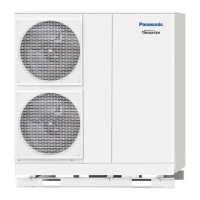112 Aquarea air-to-water heat pumps - Planning and installation manual - 02/2022
Planning
5
5.3 Hydraulics
5.3.1 Hydraulic integration
All Aquarea heat pump systems have an integrated water circulation pump that transports the
heating water into the heat transfer system. A high-eciency pump is used for the purpose.
In general, a hydraulic separation of heat pump circuit and heat consumer circuit is always
advisable if a dierent volumetric ows must be provided for the consumer circuit than is required
for the heat pump circuit. In such a case, separate pumps must be provided for the respective
circuits. To avoid these pumps inuencing each other with their dierent pressure and volumetric
ow parameters, hydraulic separation is necessary.
If, besides the integrated water circulation pump, one or more water circulation pumps are required
for the respective heating circuits, hydraulic separation of the heat pump circuit and the heat
consumer circuit through a buer tank or a low-loss header (hydraulic balancer) must be eected.
If hydraulic integration is to be achieved without hydraulic separation, it must be ensured that
the minimum ow rate of the respective heat pump (→ 4.6.2.3 Technical Data (bi-bloc systems),
S. 40, → 4.6.3.3 Technical Data (mono-bloc systems), p. 55) is maintained at all times. Using
automatically regulating mixers or thermostat valves bears the risk that the hot water circulation
is throttled down so low that the ow rate falls below the minimum. To rule this out, Panasonic
recommends to always equip heat transfer systems, which have no hydraulic separation, with
an overow valve between the supply and the return heating pipe. The overow valve is to be
designed for the nominal ow rate of the respective heat pump.
Another option is a bypass in the form of multiple non-adjustable or permanently opened heating
circuits. Rooms with a continuously high heat requirement, such as bathrooms, are particularly
suited for this purpose. Even for this variant, it is necessary to ensure that the minimum ow rate of
the heat pump is always guaranteed.
Magnetic lter
For protection of the heat pump, Panasonic recommends installing a magnetic lter on site just
before the water inlet (water return) connection on the heat pump.
System volume
Depending on the nominal heating capacity of the heat pump system, the recommendations for the
minimum total water volume in the system are as follows:
● Nominal heating capacity up to and including 9 kW: 30 litres
● Nominal heating capacity above 12 kW up to and including 16 kW: 50 litres
!
IMPORTANT
If the total water volume in the system is below the indicated values, the system volume should be
increased, e.g. by using a buer or an additional vessel.
5.3.2 Pump discharge head
Discharge head and displacement volume of the integrated water circulation pumps depend on the
respective heat pump model (see technical data of the respective pump).
Pipe network resistance
Designing the pump discharge head requires consideration of all components of the pipe network
and their individual resistances for nominal ow rate. Choose components such as mixers, valves
and heat meters such that the nominal throughput is matched to the nominal ow rate of the heat
pump system.

